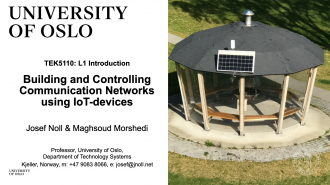TEK5110 - Building Mobile and Wireless Networks
| Wiki for ITS | ||||||
|---|---|---|---|---|---|---|
|
TEK5110 - Building Mobile and Wireless Networks
| TEK5110 | |
|---|---|
| News | Lectures on Tuesday afternoon, each autumn |
| Organisation | ITS |
| by | Josef Noll, Maghsoud Morshedi |
| Keywords |
|---|
| Abstract | The course provides knowledge on how to build networks, based on radio characteristics, mobile and wireless systems, propagation characteristics. Hands-on experiences with radio communications are used to complement the theory. |
|---|---|
| Objective (max 350 words) | Objectives to be updated, see info. This course is extending the knowledge of students into the areas of radio communications and should thus be seen as a supplement to high-frequency directional radio links and mobile radio evolutions. Focus in this course will be on radio links for personal and mobile devices covering from some cm (contactless, short range) up to some 10 meters (wireless area). The second half of the course will specific topics in building networks. Topics include: (i), Principles of radio propagation and radio interaction, (ii) Research topics in contactless, short-range and wireless radio networks, (iii) Remote management of wireless networks, and (iv) Evaluation of mobile and wireless communication systems for emerging economies. The main goal of the course is to work with scientific literature and analyse advantages and weaknesses of suggested approaches. Students will be asked to select topics, work through the related literature, perform an analysis of the literature, present the results towards the other students and discuss the advantages and shortcomings.This introductory work is mandatory for the participants, as it forms the basis for a home work, analysing selected topics in dedicated areas. The home work will be a report, and contributes to the final grade. Simulations, e.g. network throughput, business aspects or implementation work is the second topic relevant for the final grade. Participants will learn how to evaluate network, and analyse specific radio interfaces for the purpose. |
| Keywords | Radio, Antennas, Propagation, Bandwidth, Gain, Capacity, Mobile Systems, Shannon, Mobility, MobileIP, MobileIPv6, Remote Management, Emerging Economies, Digital inclusion |
| Research Area(s) | Radio technology, Network technology, Security |
| Type of course | Master |
Edit the page by Special:FormEdit/Course/TEK5110.
To add new lectures, use: Add a lecture
Goals of TEK5110
TEK5110 focusses on gaining experiences in scientific analysis, and presenting the results to the auditorium.
- The first homework will be a paper evaluation and presentation of scientific papers (20%), see TEK5110/List of papers
- Thereafter groups will be established to focus on one of the four topics (40%)
- 1. Mobile coverage, capacity and cost aspects of future mobile and wireless networks
- 2. UiO owns the access network, the model of a provider having just an access network, and collaborates with operators on handling the core network.
- 3. Internet light for all, providing free access to information for everyone. Examples might be the DigI.BasicInternet.no project on Digital health in TZ.
- 4. Wireless Network management for future services. Management will include monitoring of a real-life wireless installation, and thus allow students to analyse the network impact of services and applications with respect to wireless characteristics.
- We will have an exam contributing to 40% of the total results.
List of Papers and Group work
The goal of the paper presentation is to learn how to analyse a paper, and present it to the other students. You'll choose one topic from: TEK5110/List of papers. The links to the literature refer to available literature as student at UiO, see Guide on how to search for Literature.
Please see the description for the group work TEK5110 group work - (suggestions and criteria)
For this year, I recommend you to form groups of 3-5 people. The goal is to select one of the four scenarios listed earlier, and perform an analysis of the scenario.
- This course is a Master and PhD course (TEK5110). The PhD students will focus more on details, to be discussed with the lecturers.
- Google UNIK4700 Community: https://plus.google.com/communities/107897964181233758835
- The course takes place on Tuesdays, 1315-1600h at ITS@Kjeller (selected dates). A video communication is available to Ifi, Room Scheme@Ifi.UiO.no (room 1251).
- We'll have video streaming: mms://lux.unik.no/308
- Evaluation is based on a presentation of topics and the implementation of your scenario.
Every lecture is recorded and available at:
- mms://lux.unik.no/UNIK4700-JN/UNIK-20170822.wmv
- mms://lux.unik.no/UNIK4700-JN/UNIK-20170829.wmv
- replace 20170722 with the lecture date
To add new lectures, use: Add a lecture
Radio
- Relation between transmitted effect and received power of an antenna: Barry McLarnon - http://www.tapr.org/ve3jf.dcc97.html
Propagation
- Book chapter on propagation - http://www2.it.lut.fi/kurssit/04-05/010651000/Luennot/Chapter4.pdf
- COST 231 final report - see COST_231
Security
Books related to security:
- "UMTS Security" - Günther Horn, Dan Forsberg, Wolf-Dietrich Moeller, Valtteri Niemi, Wiley
- "LTE Security" - Valtteri Niemi, Kaisa Nyberg, Wiley
- "Entity Authentication and Personal Privacy in Future Cellular Systems", Geir Køien, River
Artikler/papere:
- G.M. Køien, "An introduction to access security in UMTS", IEEE Wireless Comm.magazine, February, 2004
- G. Rose and G.M. Køien, "Access security in CDMA2000, including a comparison with UMTS access security", IEEE Wireless Comm.magazine, February, 2004
- C.B. Sankaran, " Network access security in next- generation 3GPP systems: A tutorial ", IEEE Comm.magazine, February 2009
- G.M. Køien, " Access Security in 3GPP-based Mobile Broadband Systems", Telektronikk, 2010
3GPP spesifikasjoner: (disse finner du på 3GPP.org)
- TS 43.020 (GSM/GPRS)
- TS 33.102, 33.105, 33.102 (UMTS)
- TS 33.210
- TS 33.401, 33.402 (LTE)
- Android Tab or iPAD connectivity, as well as conference, check: Video_conference
- streaming: mms://lux.unik.no/308
Lectures
Lectures will be recorded and available through corresponding links
- mms://lux.unik.no/UNIK4700-JN/UNIK-20120831.wmv
- (dato endres med dato for forelesningen//date changes according to lecture date)
